
Bicycle
Encyclopedia
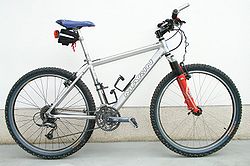
Human-powered transport
Human-powered transport is the transport of person and/or goods using human muscle power. Like animal-powered transport, human-powered transport has existed since time immemorial in the form of walking, running and swimming...
, pedal-driven
Bicycle pedal
A bicycle pedal is the part of a bicycle that the rider pushes with their foot to propel the bicycle. It provides the connection between the cyclist's foot or shoe and the crank allowing the leg to turn the bottom bracket spindle and propel the bicycle's wheels...
, single-track vehicle
Single-track vehicle
A single-track vehicle is a vehicle that leaves a single ground track as it moves forward. Single-track vehicles usually have little or no lateral stability when stationary but develop it when moving forward or controlled...
, having two wheels
Bicycle wheel
A bicycle wheel is a wheel, most commonly a wire wheel, designed for bicycle. A pair is often called a wheelset, especially in the context of ready built "off the shelf" performance-oriented wheels....
attached to a frame
Bicycle frame
A bicycle frame is the main component of a bicycle, on to which wheels and other components are fitted. The modern and most common frame design for an upright bicycle is based on the safety bicycle, and consists of two triangles, a main triangle and a paired rear triangle...
, one behind the other. A person who rides a bicycle is called a cyclist
Cycling
Cycling, also called bicycling or biking, is the use of bicycles for transport, recreation, or for sport. Persons engaged in cycling are cyclists or bicyclists...
, or bicyclist.
Bicycles were introduced in the 19th century and now number about one billion worldwide, twice as many as automobiles
Automobile
An automobile, autocar, motor car or car is a wheeled motor vehicle used for transporting passengers, which also carries its own engine or motor...
. They are the principal means of transportation
Mode of transport
Mode of transport is a term used to distinguish substantially different ways to perform transport. The most dominant modes of transport are aviation, land transport, which includes rail, road and off-road transport, and ship transport...
in many regions. They also provide a popular form of recreation, and have been adapted for such uses as children's toys, adult fitness, military and police applications, courier services and bicycle racing
Bicycle racing
Bicycle racing is a competition sport in which various types of bicycles are used. There are several categories of bicycle racing including road bicycle racing, cyclo-cross, mountain bike racing, track cycling, BMX, bike trials, and cycle speedway. Bicycle racing is recognised as an Olympic sport...
.
The basic shape and configuration of a typical upright bicycle has changed little since the first chain-driven model was developed around 1885. However, many details have been improved, especially since the advent of modern materials and computer-aided design
Computer-aided design
Computer-aided design , also known as computer-aided design and drafting , is the use of computer technology for the process of design and design-documentation. Computer Aided Drafting describes the process of drafting with a computer...
. These have allowed for a proliferation of specialized designs for particular types of cycling
Cycling
Cycling, also called bicycling or biking, is the use of bicycles for transport, recreation, or for sport. Persons engaged in cycling are cyclists or bicyclists...
.
The invention of the bicycle has had an enormous impact on society, both in terms of culture and of advancing modern industrial methods. Several components that eventually played a key role in the development of the automobile were originally invented for the bicycle, including ball bearings, pneumatic tires, chain-driven sprockets, and spoke
Spoke
A spoke is one of some number of rods radiating from the center of a wheel , connecting the hub with the round traction surface....
-tensioned wheels.
History
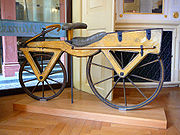
Dandy horse
The dandy-horse, also known as hobby-horse, is a human-powered vehicle that, being the first means of transport to make use of the two-wheeler principle, is regarded as the forerunner of the bicycle. The dandy horse was invented by Baron Karl Drais in Mannheim, Germany, and patented in January 1818...
was the first human means of transport to use only two wheels in tandem
Tandem
Tandem is an arrangement where a team of machines, animals or people are lined up one behind another, all facing in the same direction....
and was invented by the German Baron
Freiherr
The German titles Freiherr and Freifrau and Freiin are titles of nobility, used preceding a person's given name or, after 1919, before the surname...
Karl von Drais
Karl Drais
Karl Drais was a German inventor and invented the Laufmaschine , also later called the velocipede, draisine or "draisienne" , also nicknamed the dandy horse. This incorporated the two-wheeler principle that is basic to the bicycle and motorcycle and was the beginning of mechanized personal...
. It is regarded as the forerunner of the modern bicycle and was introduced by Drais to the public in Mannheim
Mannheim
Mannheim is a city in southwestern Germany. With about 315,000 inhabitants, Mannheim is the second-largest city in the Bundesland of Baden-Württemberg, following the capital city of Stuttgart....
in summer 1817 and in Paris in 1818. Its rider sat astride a wooden frame supported by two in-line wheels and pushed the vehicle along with his/her feet while steering the front wheel.
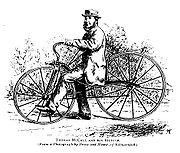
Kirkpatrick Macmillan
Kirkpatrick Macmillan was a Scottish blacksmith generally credited with inventing the rear-wheel driven bicycle.-Invention of pedal driven bicycle?:...
, a Scottish blacksmith, in 1839, although the claim is open to dispute. He is also associated with the first recorded instance of a cycling traffic offence, when a Glasgow
Glasgow
Glasgow is the largest city in Scotland and third most populous in the United Kingdom. The city is situated on the River Clyde in the country's west central lowlands...
newspaper reported in 1842 an accident in which an anonymous "gentleman from Dumfries-shire... bestride a velocipede... of ingenious design" knocked over a little girl in Glasgow and was fined five shilling
Shilling
The shilling is a unit of currency used in some current and former British Commonwealth countries. The word shilling comes from scilling, an accounting term that dates back to Anglo-Saxon times where it was deemed to be the value of a cow in Kent or a sheep elsewhere. The word is thought to derive...
s.
In the early 1860s, Frenchmen Pierre Michaux
Pierre Michaux
Pierre Michaux was a blacksmith who furnished parts for the carriage trade in Paris during the 1850s and 1860s. He started building bicycles with pedals in the early 1860s. He, or his son Ernest, may have been the inventor of this machine, by adapting cranks and pedals on the front wheel of a...
and Pierre Lallement
Pierre Lallement
Pierre Lallement is considered by some to be the inventor of the bicycle.-Early years:Lallement was born on October 25, 1843 in Pont-à-Mousson near Nancy, France....
took bicycle design in a new direction by adding a mechanical crank
Crank (mechanism)
A crank is an arm attached at right angles to a rotating shaft by which reciprocating motion is imparted to or received from the shaft. It is used to change circular into reciprocating motion, or reciprocating into circular motion. The arm may be a bent portion of the shaft, or a separate arm...
drive with pedals on an enlarged front wheel (the velocipede
Velocipede
Velocipede is an umbrella term for any human-powered land vehicle with one or more wheels. The most common type of velocipede today is the bicycle....
). Another French inventor by the name of Douglas Grasso had a failed prototype of Pierre Lallement's bicycle several years earlier. Several inventions followed using rear wheel drive, the best known being the rod-driven velocipede by Scotsman Thomas McCall
Thomas McCall
Thomas McCall was a Scottish cartwright. Born in Penpont he came to Kilmarnock at age 20, where he lived until his death ....
in 1869. The French creation, made of iron and wood, developed into the "penny-farthing
Penny-farthing
Penny-farthing, high wheel, high wheeler, and ordinary are all terms used to describe a type of bicycle with a large front wheel and a much smaller rear wheel that was popular after the boneshaker, until the development of the safety bicycle, in the 1880s...
" (historically known as an "ordinary bicycle", a retronym
Retronym
A retronym is a type of neologism that provides a new name for an object or concept to differentiate the original form or version of it from a more recent form or version. The original name is most often augmented with an adjective to account for later developments of the object or concept itself...
, since there was then no other kind). It featured a tubular steel frame on which were mounted wire-spoked wheels with solid rubber tires. These bicycles were difficult to ride due to their very high seat and poor weight distribution
Weight distribution
Weight distribution is the apportioning of weight within a vehicle, especially cars, airplanes, and trains.In a vehicle which relies on gravity in some way, weight distribution directly affects a variety of vehicle characteristics, including handling, acceleration, traction, and component life...
. In 1868 a Michaux cycle was brought to Coventry
Coventry
Coventry is a city and metropolitan borough in the county of West Midlands in England. Coventry is the 9th largest city in England and the 11th largest in the United Kingdom. It is also the second largest city in the English Midlands, after Birmingham, with a population of 300,848, although...
, England by Rowley Turner, sales agent of the Coventry Sewing Machine Company (which soon became the Coventry Machinist Company). His uncle, Josiah Turner, together with business partner James Starley
James Starley
James Starley was an English inventor and father of the bicycle industry. He was one of the most innovative and successful builders of bicycles and tricycles. His inventions include the differential gear and the perfection of chain-driven bicycles.-Early life:Starley was born in 1831 at Albourne,...
used this as a basis for the 'Coventry Model' in what became Britain's first cycle factory.
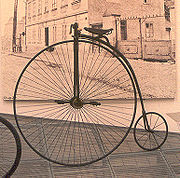
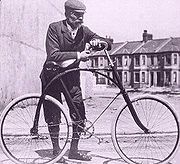
John Kemp Starley
John Kemp Starley was an English inventor and industrialist who is widely considered the inventor of the modern bicycle, and also originator of the name Rover....
(nephew of James Starley), J. H. Lawson, and Shergold solved this problem by introducing the chain drive
Chain drive
Chain drive is a way of transmitting mechanical power from one place to another. It is often used to convey power to the wheels of a vehicle, particularly bicycles and motorcycles...
(originated by the unsuccessful "bicyclette" of Englishman Henry Lawson), connecting the frame-mounted cranks to the rear wheel. These models were known as dwarf safeties, or safety bicycles, for their lower seat height and better weight distribution. (Although without pneumatic tires the ride of the smaller wheeled bicycle would be much rougher than that of the larger wheeled variety.) Starley's 1885 Rover, manufactured in Coventry, England, is usually described as the first recognizably modern bicycle. Soon, the seat tube was added, creating the double-triangle diamond frame of the modern bike.
Further innovations increased comfort and ushered in a second bicycle craze, the 1890s' Golden Age of Bicycles. In 1888, Scotsman John Boyd Dunlop
John Boyd Dunlop
John Boyd Dunlop was a Scottish inventor. He was one of the founders of the rubber company that bore his name, Dunlop Pneumatic Tyre Company....
introduced the first practical pneumatic tire, which soon became universal. Soon after, the rear freewheel
Freewheel
thumb|Freewheel mechanismIn mechanical or automotive engineering, a freewheel or overrunning clutch is a device in a transmission that disengages the driveshaft from the driven shaft when the driven shaft rotates faster than the driveshaft...
was developed, enabling the rider to coast. This refinement led to the 1890s invention of coaster brakes. Derailleur gears
Derailleur gears
Derailleur gears are a variable-ratio transmission system commonly used on bicycles, consisting of a chain, multiple sprockets of different sizes, and a mechanism to move the chain from one sprocket to another...
and hand-operated cable-pull brakes
Bicycle brake systems
A bicycle brake is used to slow down or stop a bicycle. There have been various types of brake used throughout history, and several are still in use today...
were also developed during these years, but were only slowly adopted by casual riders. By the turn of the century, cycling club
Cycling club
A cycling club is a society for cyclists. It can be local or national, general or specialised. The Cyclists' Touring Club, CTC) in the United Kingdom is a national association; i-Team and are internet clubs; the Tricycle Association, Tandem Club and the Veterans Time Trial Association, for those...
s flourished on both sides of the Atlantic, and touring and racing became widely popular.
Bicycles and horse buggies were the two mainstays of private transportation just prior to the automobile, and the grading of smooth roads in the late 19th century was stimulated by the widespread advertising, production, and use of these devices.
Uses
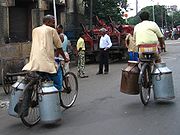
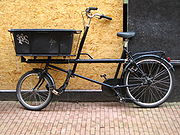
- Utility: bicycle commutingBicycle commutingBicycle commuting is the use of a bicycle to travel from home to a place of work or study — in contrast to the use of a bicycle for sport, recreation or touring....
and utility cyclingUtility cyclingUtility cycling encompasses any cycling not done primarily for fitness, recreation such as cycle touring, or sport such as cycle racing, but simply as a means of transport... - Work: mail deliveryMailMail, or post, is a system for transporting letters and other tangible objects: written documents, typically enclosed in envelopes, and also small packages are delivered to destinations around the world. Anything sent through the postal system is called mail or post.In principle, a postal service...
, paramedicParamedicA paramedic is a healthcare professional that works in emergency medical situations. Paramedics provide advanced levels of care for medical emergencies and trauma. The majority of paramedics are based in the field in ambulances, emergency response vehicles, or in specialist mobile units such as...
s, policePolice bicycleA Police bicycle is a land vehicle used by police departments, most commonly in the form of a mountain bicycle. They are designed to meet the requirements unique to each department....
, courieringBicycle messengerBicycle messengers are people who work for courier companies carrying and delivering items by bicycle. Bicycle messengers are most often found in the central business districts of metropolitan areas...
, and general deliveryDelivery (commerce)Delivery is the process of transporting goods. Most goods are delivered through a transportation network. Cargo are primarily delivered via roads and railroads on land, shipping lanes on the sea and airline networks in the air...
. - Recreation: bicycle touringBicycle touringBicycle touring is cycling over long distances – prioritizing pleasure and endurance over utility or speed. Touring can range from single day 'supported' rides — e.g., rides to benefit charities — where provisions are available to riders at stops along the route, to multi-day...
, mountain bikingMountain bikingMountain biking is a sport which consists of riding bicycles off-road, often over rough terrain, using specially adapted mountain bikes. Mountain bikes share similarities with other bikes, but incorporate features designed to enhance durability and performance in rough terrain.Mountain biking can...
, BMXBMXBicycle motocross or BMX refers to the sport in which the main goal is extreme racing on bicycles in motocross style on tracks with inline start and expressive obstacles, and it is also the term that refers to the bicycle itself that is designed for dirt and motocross cycling.- History :BMX started...
and physical fitnessPhysical fitnessPhysical fitness comprises two related concepts: general fitness , and specific fitness...
. - RacingBicycle racingBicycle racing is a competition sport in which various types of bicycles are used. There are several categories of bicycle racing including road bicycle racing, cyclo-cross, mountain bike racing, track cycling, BMX, bike trials, and cycle speedway. Bicycle racing is recognised as an Olympic sport...
: track racingTrack cyclingTrack cycling is a bicycle racing sport usually held on specially built banked tracks or velodromes using track bicycles....
, criteriumCriteriumA criterium, or crit, is a bike race held on a short course , often run on closed-off city center streets....
, roller racingBicycle rollersBicycle rollers are a type of bicycle trainer that make it possible to ride a bicycle indoors without moving forward. However, unlike other types of bicycle trainers, rollers do not attach to the bicycle frame, and the rider must balance him or herself on the rollers while training...
and time trialTime trialIn many racing sports an athlete will compete in a time trial against the clock to secure the fastest time. In cycling, for example, a time trial can be a single track cycling event, or an individual or team time trial on the road, and either or both of the latter may form components of...
to multi-stage events like the Tour of California, Giro d'ItaliaGiro d'ItaliaThe Giro d'Italia , also simply known as The Giro, is a long distance road bicycle racing stage race for professional cyclists held over three weeks in May/early June in and around Italy. The Giro is one of the three Grand Tours , and is part of the UCI World Ranking calendar...
, the Tour de FranceTour de FranceThe Tour de France is an annual bicycle race held in France and nearby countries. First staged in 1903, the race covers more than and lasts three weeks. As the best known and most prestigious of cycling's three "Grand Tours", the Tour de France attracts riders and teams from around the world. The...
, the Vuelta a EspañaVuelta a EspañaThe Vuelta a España is a three-week road bicycle racing stage race that is one of the three "Grand Tours" of Europe and part of the UCI World Ranking calendar. The race lasts three weeks and attracts cyclists from around the world. The race is broken into day-long segments, called stages...
, the Volta a PortugalVolta a PortugalThe Volta a Portugal em bicicleta is a long distance road bicycle race for professionals held in Portugal. The competition takes place annually during a two-week span.- History :...
, among others. - Military: scoutingReconnaissanceReconnaissance is the military term for exploring beyond the area occupied by friendly forces to gain information about enemy forces or features of the environment....
, troop movement, supply of provisions, and patrol. See bicycle infantryBicycle infantryBicycle infantry are infantry soldiers who maneuver on battlefields using bicycles. The term dates from the late 19th century, when the "safety bicycle" became popular in Europe, the United States and Australia. Historically, bicycles lessened the need for horses, fuel and vehicle maintenance...
. - Show: entertainment and performance, e.g. Artistic cyclingArtistic cyclingArtistic cycling is a form of competitive indoor cycling in which athletes perform tricks for points on specialized, fixed-gear bikes in a format similar to ballet or gymnastics...
s.
Technical aspects

Types
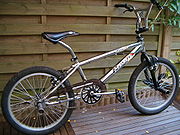
Utility bicycle
A utility bicycle is a bicycle designed for practical transportation, as opposed to bicycles which are primarily designed for recreation and competition, such as touring bicycles, racing bicycles, sport/training bicycles, and mountain bicycles. The vast majority of bicycles can be found in the...
s, mountain bicycles, racing bicycle
Racing bicycle
A racing bicycle, also known as a road bike, is a bicycle designed for competitive road cycling, a sport governed by according to the rules of the Union Cycliste Internationale...
s, touring bicycle
Touring bicycle
A touring bicycle is a bicycle designed or modified to handle bicycle touring. To make the bikes sufficiently robust, comfortable and capable of carrying heavy loads, special features may include a long wheelbase , frame materials that favor flexibility over rigidity , heavy duty wheels , and...
s, hybrid bicycle
Hybrid bicycle
A hybrid bicycle is a bicycle designed for general-purpose utility and commuting on a wide variety of surfaces, including paved and unpaved roads, paths and trails...
s, cruiser bicycle
Cruiser bicycle
Cruiser bicycles, also known as beach cruisers, combine balloon tires, upright seating posture, single-speed drivetrains, and straightforward steel construction with expressive styling...
s, and BMX Bikes
BMX bike
A BMX bike or BMX is the name of a popular bicycle used for both casual use and sport, and designed mainly for dirt and motocross cycling...
. Less common are tandems
Tandem bicycle
The tandem bicycle or twin is a form of bicycle designed to be ridden by more than one person. The term tandem refers to the seating arrangement , not the number of riders. A bike with two riders side-by-side is called a sociable.-History:Patents related to tandem bicycles date from the late 19th...
, lowriders
Lowrider bicycle
A lowrider bicycle is a highly customized bicycle with a long wheelbase and stylings inspired by lowrider cars. These bikes often feature a long, curved banana seat with a sissy bar and very tall upward-swept ape hanger handlebars...
, tall bike
Tall bike
A tall bike is an unusually tall bicycle often constructed by hobbyists from spare parts. Typically, two conventional bicycle frames are connected, by welding, brazing, or other means, one atop the other...
s, fixed gear
Fixed-gear bicycle
A fixed-gear bicycle is a bicycle that has no freewheel, meaning it cannot coast, as the pedals are always in motion when the bicycle is moving....
, folding models
Folding bicycle
A folding bicycle is a bicycle designed to fold into a compact form, facilitating transport and storage. When folded, the bikes can be more easily carried into buildings and workplaces or onto public transportation or more easily stored in compact living quarters or aboard a car, boat or plane...
, amphibious bicycles and recumbents
Recumbent bicycle
A recumbent bicycle is a bicycle that places the rider in a laid-back reclining position. Most recumbent riders choose this type of design for ergonomic reasons; the rider's weight is distributed comfortably over a larger area, supported by back and buttocks...
(one of which was used to set the IHPVA Hour record).
Unicycle
Unicycle
A unicycle is a human-powered, single-track vehicle with one wheel. Unicycles resemble bicycles, but are less complex.-History:One theory of the advent of the unicycle stems from the popularity of the penny-farthing during the late 19th century...
s, tricycle
Tricycle
A tricycle is a three-wheeled vehicle. While tricycles are often associated with the small three-wheeled vehicles used by pre-school-age children, they are also used by adults for a variety of purposes. In the United States and Canada, adult-sized tricycles are used primarily by older persons for...
s and quadracycles are not strictly bicycles, as they have respectively one, three and four wheels, but are often referred to informally as "bikes".
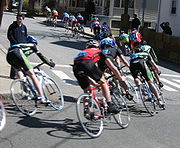
Dynamics
A bicycle stays upright while moving forward by being steered so as to keep its center of massCenter of mass
In physics, the center of mass or barycenter of a system is the average location of all of its mass. In the case of a rigid body, the position of the center of mass is fixed in relation to the body...
over the wheels. This steering is usually provided by the rider, but under certain conditions may be provided by the bicycle itself.
The combined center of mass of a bicycle and its rider must lean into a turn to successfully navigate it. This lean is induced by a method known as countersteering
Countersteering
Countersteering is the technique used by single-track vehicle operators, such as cyclists and motorcyclists, to initiate a turn toward a given direction by momentarily steering counter to the desired direction...
, which can be performed by the rider turning the handlebars directly with the hands or indirectly by leaning the bicycle.
Short-wheelbase or tall bicycles
Tall bike
A tall bike is an unusually tall bicycle often constructed by hobbyists from spare parts. Typically, two conventional bicycle frames are connected, by welding, brazing, or other means, one atop the other...
, when braking, can generate enough stopping force at the front wheel to flip longitudinally. The act of purposefully using this force to lift the rear wheel and balance on the front without tipping over is a trick known as a stoppie
Stoppie
The stoppie , is a motorcycle and bicycle trick in which the back wheel is lifted and the bike is ridden on the front wheel by carefully applying brake pressure. It is also sometimes called a front wheelie.-General description:...
, endo or front wheelie.
Performance
The bicycle is extraordinarily efficient in both biological and mechanical terms. The bicycle is the most efficient human-powered means of transportation in terms of energy a person must expend to travel a given distance. From a mechanical viewpoint, up to 99% of the energy delivered by the rider into the pedals is transmitted to the wheels, although the use of gearing mechanisms may reduce this by 10–15%.In terms of the ratio of cargo weight a bicycle can carry to total weight, it is also an efficient means of cargo transportation.
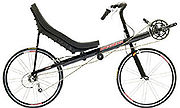
In addition, the carbon dioxide
Carbon dioxide
Carbon dioxide is a naturally occurring chemical compound composed of two oxygen atoms covalently bonded to a single carbon atom...
generated in the production and transportation of the food required by the bicyclist, per mile traveled, is less than 1/10 that generated by energy efficient cars.
Construction and parts
In its early years, bicycle construction drew on pre-existing technologies. More recently, bicycle technology has in turn contributed ideas in both old and new areas.Frame
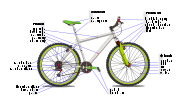
Such upright bicycles almost always feature the diamond frame, a truss
Truss
In architecture and structural engineering, a truss is a structure comprising one or more triangular units constructed with straight members whose ends are connected at joints referred to as nodes. External forces and reactions to those forces are considered to act only at the nodes and result in...
consisting of two triangles: the front triangle and the rear triangle. The front triangle consists of the head tube, top tube, down tube and seat tube. The head tube contains the headset
Headset (bicycle part)
The headset is the set of components on a bicycle that provides a rotatable interface between the bicycle fork and the head tube of the bicycle frame itself. The short tube through which the steerer of the fork passes is called the head tube. A typical headset consists of two cups that are pressed...
, the set of bearings that allows the fork
Bicycle fork
A bicycle fork is the portion of a bicycle that holds the front wheel and allows the rider to steer and balance the bicycle. A fork consists of two fork ends which hold the front wheel axle, two blades which join at a fork crown, and a steerer or steering tube to which the handlebars attach ...
to turn smoothly for steering and balance. The top tube connects the head tube to the seat tube at the top, and the down tube connects the head tube to the bottom bracket
Bottom bracket
The bottom bracket on a bicycle connects the crankset to the bicycle and allows the crankset to rotate freely. It contains a spindle that the crankset attaches to, and the bearings that allow the spindle and cranks to rotate. The chainrings and pedals attach to the cranks...
. The rear triangle consists of the seat tube and paired chain stays and seat stays. The chain stays run parallel to the chain
Bicycle chain
A bicycle chain is a roller chain that transfers power from the pedals to the drive-wheel of a bicycle, thus propelling it. Most bicycle chains are made from plain carbon or alloy steel, but some are nickel-plated to prevent rust, or simply for aesthetics. Nickel also confers a measure of...
, connecting the bottom bracket to the rear fork ends
Dropout (bicycle part)
A bicycle dropout is a type of fork end that allows the rear wheel to be removed without first derailing the chain. The more inclusive term fork end refers to a slot in a frame or fork where the axle of the wheel is attached....
. The seat stays connect the top of the seat tube (at or near the same point as the top tube) to the rear fork ends.
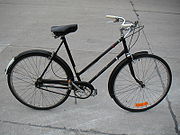
Step-through frame
A step-through frame is a type of bicycle frame, often used for utility bicycles, with a low or absent top tube or cross-bar....
, allows the rider to mount and dismount in a dignified way while wearing a skirt or dress. While some women's bicycles continue to use this frame style, there is also a variation, the mixte, which splits the top tube laterally into two thinner top tubes that bypass the seat tube on each side and connect to the rear fork ends. The ease of stepping through is also appreciated by those with limited flexibility or other joint problems. Because of its persistent image as a "women's" bicycle, step-through frames are not common for larger frames.
Another style is the recumbent bicycle
Recumbent bicycle
A recumbent bicycle is a bicycle that places the rider in a laid-back reclining position. Most recumbent riders choose this type of design for ergonomic reasons; the rider's weight is distributed comfortably over a larger area, supported by back and buttocks...
. These are inherently more aerodynamic than upright versions, as the rider may lean back onto a support and operate pedals that are on about the same level as the seat. The world's fastest bicycle is a recumbent bicycle but this type was banned from competition in 1934 by the Union Cycliste Internationale
Union Cycliste Internationale
Union Cycliste Internationale is the world governing body for sports cycling and oversees international competitive cycling events. The UCI is based in Aigle, Switzerland....
.
Historically, materials used in bicycles have followed a similar pattern as in aircraft, the goal being high strength and low weight. Since the late 1930s alloy steels have been used for frame and fork tubes in higher quality machines. Celluloid
Celluloid
Celluloid is the name of a class of compounds created from nitrocellulose and camphor, plus dyes and other agents. Generally regarded to be the first thermoplastic, it was first created as Parkesine in 1862 and as Xylonite in 1869, before being registered as Celluloid in 1870. Celluloid is...
found application in mudguards, and aluminum alloys
Aluminium alloy
Aluminium alloys are alloys in which aluminium is the predominant metal. The typical alloying elements are copper, magnesium, manganese, silicon and zinc. There are two principal classifications, namely casting alloys and wrought alloys, both of which are further subdivided into the categories...
are increasingly used in components such as handlebars, seat post
Seatpost
A bicycle seatpost, seatpin, saddlepole, saddle pillar, or saddle pin is a tube that extends upwards from the bicycle frame to the saddle. The amount that it extends out of the frame can usually be adjusted, and there is usually a mark that indicates the minimum insertion...
, and brake levers. In the 1980s aluminum alloy frames became popular for their lightness, and their affordability now makes them common. More expensive carbon fiber and titanium frames are now also available, as well as advanced steel alloys and even bamboo.
Drivetrain and gearing
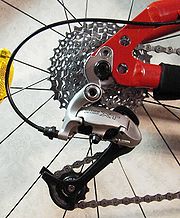
Bicycle pedal
A bicycle pedal is the part of a bicycle that the rider pushes with their foot to propel the bicycle. It provides the connection between the cyclist's foot or shoe and the crank allowing the leg to turn the bottom bracket spindle and propel the bicycle's wheels...
which rotate the cranks, which are held in axis by the bottom bracket
Bottom bracket
The bottom bracket on a bicycle connects the crankset to the bicycle and allows the crankset to rotate freely. It contains a spindle that the crankset attaches to, and the bearings that allow the spindle and cranks to rotate. The chainrings and pedals attach to the cranks...
. Most bicycles use a chain to transmit power to the rear wheel. A relatively small number of bicycles use a shaft drive to transmit power. A very small number of bicycles (mainly single-speed bicycle
Single-speed bicycle
A single-speed bicycle is a type of bicycle with a single gear ratio. These bicycles are without derailleur gears, hub gearing or other methods for varying the gear ratio of the bicycle....
s intended for short-distance commuting) use a belt drive as an oil-free way of transmitting power.
Since cyclists' legs are most efficient over a narrow range of pedaling speeds (cadence
Cadence (cycling)
In cycling, cadence is the number of revolutions of the crank per minute; roughly speaking, this is the rate at which a cyclist is pedalling/turning the pedals...
), a variable gear ratio
Gear ratio
The gear ratio of a gear train is the ratio of the angular velocity of the input gear to the angular velocity of the output gear, also known as the speed ratio of the gear train. The gear ratio can be computed directly from the numbers of teeth of the various gears that engage to form the gear...
helps a cyclist to maintain an optimum pedalling speed while covering varied terrain. As a first approximation, utility bicycle
Utility bicycle
A utility bicycle is a bicycle designed for practical transportation, as opposed to bicycles which are primarily designed for recreation and competition, such as touring bicycles, racing bicycles, sport/training bicycles, and mountain bicycles. The vast majority of bicycles can be found in the...
s often use a hub gear
Hub gear
A hub gear, internal-gear hub, or just gear hub is a gear ratio changing system commonly used on bicycles that is implemented with planetary or epicyclic gears. The gears and lubricants are sealed within the hub-shell of the bicycle's rear wheel, as opposed to derailleur gears, where the gears and...
with a small number (3 to 8) of widely spaced gears, road bicycle
Road bicycle
The term road bicycle is used to describe bicycles built for traveling at speed on paved roads. Some sources use the term to mean racing bicycle...
s and racing bicycle
Racing bicycle
A racing bicycle, also known as a road bike, is a bicycle designed for competitive road cycling, a sport governed by according to the rules of the Union Cycliste Internationale...
s use derailleur gears
Derailleur gears
Derailleur gears are a variable-ratio transmission system commonly used on bicycles, consisting of a chain, multiple sprockets of different sizes, and a mechanism to move the chain from one sprocket to another...
with a moderate number (10 to 22) of closely spaced gear ratios, while mountain bicycles
Mountain bike
A mountain bike or mountain bicycle is a bicycle created for off-road cycling. This activity includes traversing of rocks and washouts, and steep declines,...
, hybrid bicycle
Hybrid bicycle
A hybrid bicycle is a bicycle designed for general-purpose utility and commuting on a wide variety of surfaces, including paved and unpaved roads, paths and trails...
s, and touring bicycle
Touring bicycle
A touring bicycle is a bicycle designed or modified to handle bicycle touring. To make the bikes sufficiently robust, comfortable and capable of carrying heavy loads, special features may include a long wheelbase , frame materials that favor flexibility over rigidity , heavy duty wheels , and...
s use dérailleur gears with a larger number (15 to 33) of moderately spaced gear ratios, often including an extremely low gear ("granny gear") for climbing steep hills.
Different gears and ranges of gears are appropriate for different people and styles of cycling. Multi-speed bicycles allow gear selection to suit the circumstances: a cyclist could use a high gear when cycling downhill, a medium gear when cycling on a flat road, and a low gear when cycling uphill. In a lower gear every turn of the pedals leads to fewer rotations of the rear wheel. This allows the energy required to move the same distance to be distributed over more pedal turns, reducing fatigue when riding uphill, with a heavy load, or against strong winds. A higher gear allows a cyclist to make fewer pedal turns to maintain a given speed, but with more effort per turn of the pedals.
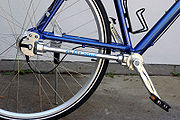
Bicycle chain
A bicycle chain is a roller chain that transfers power from the pedals to the drive-wheel of a bicycle, thus propelling it. Most bicycle chains are made from plain carbon or alloy steel, but some are nickel-plated to prevent rust, or simply for aesthetics. Nickel also confers a measure of...
, which in turn rotates the rear wheel via the rear sprocket
Sprocket
A sprocket or sprocket-wheel is a profiled wheel with teeth, cogs, or even sprockets that mesh with a chain, track or other perforated or indented material. The name 'sprocket' applies generally to any wheel upon which are radial projections that engage a chain passing over it...
(s) (cassette
Cassette (bicycle part)
On a bicycle, the cogset or cluster is the set of multiple rear sprockets that attaches to the hub on the rear wheel. A cogset works with a rear derailleur as part of the drivetrain to provide multiple gear ratios to the rider. Cogsets come in two varieties, cassettes or freewheels, of which...
or freewheel). There are four gearing options: two-speed hub gear integrated with chain ring, up to 3 chain rings, up to 11 sprockets, hub gear built in to rear wheel (3-speed to 14-speed). The most common options are either a rear hub or multiple chain rings combined with multiple sprockets (other combinations of options are possible but less common).
With a shaft drive
Shaft-driven bicycle
A shaft-driven bicycle is a bicycle that uses a drive shaft instead of a chain to transmit power from the pedals to the wheel. Shaft drives were introduced over a century ago, but were mostly supplanted by chain-driven bicycles due to the gear ranges possible with sprockets and derailleurs...
transmission, a gear set at the bottom bracket turns the shaft, which then turns the rear wheel via a gear set connected to the wheel's hub. There is some small loss of efficiency due to the two gear sets needed. The only gearing option with a shaft drive is to use a hub gear
Hub gear
A hub gear, internal-gear hub, or just gear hub is a gear ratio changing system commonly used on bicycles that is implemented with planetary or epicyclic gears. The gears and lubricants are sealed within the hub-shell of the bicycle's rear wheel, as opposed to derailleur gears, where the gears and...
.
Steering and seating
The handlebarsBicycle handlebar
Bicycle handlebar or often bicycle handlebars refers to the steering mechanism for bicycles; the equivalent of a steering wheel. Besides steering, handlebars also often support a portion of the rider's weight, depending on their riding position, and provide a convenient mounting place for brake...
turn the fork
Bicycle fork
A bicycle fork is the portion of a bicycle that holds the front wheel and allows the rider to steer and balance the bicycle. A fork consists of two fork ends which hold the front wheel axle, two blades which join at a fork crown, and a steerer or steering tube to which the handlebars attach ...
and the front wheel via the stem, which rotates within the headset
Headset (bicycle part)
The headset is the set of components on a bicycle that provides a rotatable interface between the bicycle fork and the head tube of the bicycle frame itself. The short tube through which the steerer of the fork passes is called the head tube. A typical headset consists of two cups that are pressed...
. Three styles of handlebar are common. Upright handlebars, the norm in Europe and elsewhere until the 1970s, curve gently back toward the rider, offering a natural grip and comfortable upright position. Drop handlebars "drop" as they curve forward and down, offering the cyclist best braking power from a more aerodynamic "crouched" position, as well as more upright positions in which the hands grip the brake lever mounts, the forward curves, or the upper flat sections for increasingly upright postures. Mountain bikes generally feature a 'straight handlebar' or 'riser bar' with varying degrees of sweep backwards and centimeters rise upwards, as well as wider widths which can provide better handling due to increased leverage against the wheel.

Bicycle saddle
A bicycle saddle, often called a seat, is one of three contact points on an upright bicycle, the others being the pedals and the handlebars.The bicycle saddle has been known as such since the bicycle evolved from the draisine, a forerunner of the bicycle...
also vary with rider preference, from the cushioned ones favored by short-distance riders to narrower saddles which allow more room for leg swings. Comfort depends on riding position. With comfort bikes and hybrids, cyclists sit high over the seat, their weight directed down onto the saddle, such that a wider and more cushioned saddle is preferable. For racing bikes where the rider is bent over, weight is more evenly distributed between the handlebars and saddle, the hips are flexed, and a narrower and harder saddle is more efficient. Differing saddle designs exist for male and female cyclists, accommodating the genders' differing anatomies, although bikes typically are sold with saddles most appropriate for men.
A recumbent bicycle has a reclined chair-like seat
Bicycle seat
A bicycle seat, unlike a bicycle saddle, is designed to support the rider's buttocks and back, usually in a semi-reclined position. Arthur Garford is credited with inventing the padded bicycle seat in 1892, and they are now usually found on recumbent bicycles.Bicycle seats come in three main...
that some riders find more comfortable than a saddle, especially riders who suffer from certain types of seat, back, neck, shoulder, or wrist pain. Recumbent bicycles may have either under-seat or over-seat steering.
Brakes
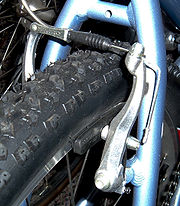
Tandem bicycle
The tandem bicycle or twin is a form of bicycle designed to be ridden by more than one person. The term tandem refers to the seating arrangement , not the number of riders. A bike with two riders side-by-side is called a sociable.-History:Patents related to tandem bicycles date from the late 19th...
s and recumbent bicycles than on road-specific bicycles.
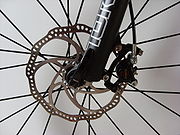
Bowden cable
A Bowden cable is a type of flexible cable used to transmit mechanical force or energy by the movement of an inner cable relative to a hollow outer cable housing...
s or hydraulic lines to the friction pads. A rear hub brake may be either hand-operated or pedal-actuated, as in the back pedal coaster brakes which were popular in North America until the 1960s, and are common in children's bicycles.
Track bicycle
Track bicycle
A track bicycle or track bike is a bicycle optimized for racing at a velodrome or outdoor track. Unlike road bicycles, the track bike is a fixed-gear bicycle and so has a single gear and neither freewheel nor brakes. Tires are narrow and inflated to high pressure to reduce rolling resistance...
s do not have dedicated brakes. Brakes are not required for riding on a track because all riders ride in the same direction around a track which does not necessitate sharp deceleration. Track riders are still able to slow down because all track bicycles are fixed-gear
Fixed-gear bicycle
A fixed-gear bicycle is a bicycle that has no freewheel, meaning it cannot coast, as the pedals are always in motion when the bicycle is moving....
, meaning that there is no freewheel
Freewheel
thumb|Freewheel mechanismIn mechanical or automotive engineering, a freewheel or overrunning clutch is a device in a transmission that disengages the driveshaft from the driven shaft when the driven shaft rotates faster than the driveshaft...
. Without a freewheel, coasting is impossible, so when the rear wheel is moving, the crank is moving. To slow down, the rider applies resistance to the pedals – this acts as a braking system which can be as effective as a friction-based rear wheel brake, but not as effective as a front wheel brake.
Suspension
Bicycle suspension refers to the system or systems used to suspend the rider and all or part of the bicycle. This serves two purposes:- To keep the wheels in continuous contact with rough surfaces to improve control.
- To isolate the rider and luggage from jarring due to rough surfaces.
Bicycle suspensions are used primarily on mountain bicycles, but are also common on hybrid bicycles, and can even be found on some road bicycles, as they can help deal with problematic vibration. Suspension is especially important on recumbent bicycles, since while an upright bicycle rider can stand on the pedals to achieve some of the benefits of suspension, a recumbent rider cannot.
Wheels and tires
The wheel axle fits into fork endsDropout (bicycle part)
A bicycle dropout is a type of fork end that allows the rear wheel to be removed without first derailing the chain. The more inclusive term fork end refers to a slot in a frame or fork where the axle of the wheel is attached....
in the frame
Bicycle frame
A bicycle frame is the main component of a bicycle, on to which wheels and other components are fitted. The modern and most common frame design for an upright bicycle is based on the safety bicycle, and consists of two triangles, a main triangle and a paired rear triangle...
and fork
Bicycle fork
A bicycle fork is the portion of a bicycle that holds the front wheel and allows the rider to steer and balance the bicycle. A fork consists of two fork ends which hold the front wheel axle, two blades which join at a fork crown, and a steerer or steering tube to which the handlebars attach ...
. A pair of wheels may be called a wheelset, especially in the context of ready-built "off the shelf", performance-oriented wheels.
Tires vary enormously. Skinny 18 to 25 millimeters wide, road-racing tires may be completely smooth, or (slick
Slick tire
A slick tyre is a type of tyre that has no tread pattern, used mostly in auto racing. The first production "slick tyre" was developed by a company called M&H Tires in the early 1950s for use in drag racing...
). On the opposite extreme, off-road tires are 38 to 64 millimeters wide and usually have a deep tread for gripping in muddy conditions or metal studs for ice.
Accessories, repairs, and tools
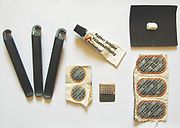
Fender (vehicle)
Fender is the US English term for the part of an automobile, motorcycle or other vehicle body that frames a wheel well . Its primary purpose is to prevent sand, mud, rocks, liquids, and other road spray from being thrown into the air by the rotating tire. Fenders are typically rigid and can be...
s, protect the cyclist and moving parts
Moving parts
The moving parts of a machine are those parts of it that move. Machines comprise both moving and fixed parts. The moving parts have controlled and constrained motions....
from spray when riding through wet areas and chainguards protect clothes from oil on the chain while preventing clothing from being caught between the chain and crankset
Crankset
The crankset or chainset , is the component of a bicycle drivetrain that converts the reciprocating motion of the rider's legs into rotational motion used to drive the chain, which in turn drives the rear wheel...
teeth. Kick stands keep a bicycle upright when parked, while a bike lock will help prevent it from being stolen. Front-mounted baskets
Bicycle basket
A bicycle basket allows a bicycle rider to carry cargo or objects without using their hands. Baskets on children's bicycles and some utility bicycles are often mounted to the front handle bars and are made of wire mesh, wicker, or woven plastic...
for carrying goods are often used. Luggage carrier
Luggage carrier
A luggage carrier, also commonly called a rack, is a device attached to a bicycle to which cargo or panniers can be attached. This is popular with utility bicycles and touring bicycles....
s and pannier
Pannier
A pannier is a basket, bag, box, or similar container, carried in pairs either slung over the back of a beast of burden, or attached to the sides of a bicycle or motorcycle. The term derives from the Old French, from Classical Latin, word for bread basket....
s mounted above the rear tire can be used to carry equipment or cargo. Parents sometimes add rear-mounted child seats
Baby transport
Baby transport consists of devices for transporting and carrying infants. A "child carrier" or "baby carrier" is a device used to carry an infant or small child on the body of an adult...
and/or an auxiliary saddle fitted to the crossbar to transport children.
Toe-clips and toestraps and clipless pedals help keep the foot locked in the proper position on the pedals, and enable the cyclist to pull as well as push the pedals—although not without their hazards, e.g. may lock foot in when needed to prevent a fall. Technical accessories include cyclocomputer
Cyclocomputer
A cyclocomputer or cyclometer is a device mounted on a bicycle that calculates and displays trip information, similar to the instruments in the dashboard of a car. The computer with display, or head unit, usually is attached to the handlebar for easy viewing.-History:In 1895 Curtis Hussey Veeder...
s for measuring speed, distance, heart rate, GPS data etc. Other accessories include lights
Bicycle lighting
Bicycle lighting improves the visibility of the bicycle rider to others in dark conditions, i.e. to increase the rider's conspicuity and to enhance the ability of the rider to see, illuminating the way forward. Both reflectors and active lights are used to make the rider more visible, and many ...
, reflectors, security locks
Bicycle lock
A bicycle lock is a physical security device used on a bicycle to prevent theft. It is generally used to fasten the bicycle to a bicycle stand or other immovable object....
, mirror, water bottles and cages
Bottle cage
A bottle cage is device used to affix a water bottle to a bicycle. Composed of plastic, aluminum, stainless steel, titanium or carbon fiber, it is attached to the main frame of a bicycle, the handlebars, or behind the saddle...
, and bell
Bicycle bell
A bicycle bell is a bell mounted on a bicycle for warning pedestrians and other cyclists. They are a required piece of equipment is some jurisdictions. They usually mounted on the handlebars and thumb activated...
.
Bicycle helmet
Bicycle helmet
A bicycle helmet is a helmet intended to be worn while riding a bicycle. They are designed to attenuate impacts to the skull of a cyclist in falls while minimizing side effects such as interference with peripheral vision...
s may help reduce injury in the event of a collision or accident, and a certified helmet is legally required for some riders in some jurisdictions. Helmets are classified as an accessory or an item of clothing by others.
Many cyclists carry tool kits. These may include a tire patch kit (which, in turn, may contain any combination of a hand pump
Bicycle pump
A bicycle pump is a type of positive-displacement pump specifically designed for inflating bicycle tires. It has a connection or adapter for use with one or both of the two most common types of valves used on bicycles, Schrader or Presta...
or CO2 Pump, tire levers, spare tubes, self-adhesive patches, or tube-patching material, an adhesive, a piece of sandpaper or a metal grater (for roughing the tube surface to be patched), and sometimes even a block of French chalk
French chalk
French chalk is a form of steatite.As an arist's material the term is used by Max Doerner in his book "The Materials of the Artist" where he describes a calcium carbonate used to make traditional gesso primer, to be painted over...
.), wrench
Wrench
A wrench or spanner is a tool used to provide grip and mechanical advantage in applying torque to turn objects—usually rotary fasteners, such as nuts and bolts—or keep them from turning....
es, hex key
Hex key
A hex key, Allen key, or Allen wrench is a tool of hexagonal cross-section used to drive bolts and screws that have a hexagonal socket in the head .- Nomenclature :...
s, screwdrivers, and a chain tool
Chain tool
400px|thumb|right|A typical chain tool. With a chain placed on the central sprocket, the screw is turned until a pin is pushed from the linkageA chain tool is a small mechanical device used to "break" a bicycle chain in such a way that it can be mended with the same tool. A bicycle chain has...
. There are also cycling specific multi-tool
Multi-tool
A multi-tool is any one of a range of portable, versatile hand tools that combines several individual functions in a single unit...
s that combine many of these implements into a single compact device. More specialized bicycle components may require more complex tools, including proprietary tools specific for a given manufacturer.
Some bicycle parts, particularly hub-based gearing systems, are complex, and many cyclists prefer to leave maintenance and repairs to professional bicycle mechanic
Bicycle mechanic
A bicycle mechanic is a mechanic who can perform a wide range of repairs on bicycles. Bike mechanics can be employed in various types of stores, ranging from large department stores to small local bike shops; cycling teams, or bicycle manufacturers....
s. In some areas it is possible to purchase road-side assistance from companies such as the Better World Club
Better World Club
The Better World Club provides services to motorists in the USA, and supports organizations seeking to reduce the environmental damage done by automobiles. BWC, which describes itself as "the nation's only environmentally friendly auto club", offers a bicycle membership and caters to hybrid vehicle...
. Other cyclists maintain their own bicycles, perhaps as part of their enjoyment of the hobby of cycling or simply for economic reasons. A cyclist's ability to repair and maintain their own bicycle is also celebrated within the DIY movement.
Standards
A number of formal and industry standards exist for bicycle components to help make spare parts exchangeable and to maintain a minimum product safety.The International Organization for Standardization
International Organization for Standardization
The International Organization for Standardization , widely known as ISO, is an international standard-setting body composed of representatives from various national standards organizations. Founded on February 23, 1947, the organization promulgates worldwide proprietary, industrial and commercial...
, ISO, has a special technical committee for cycles, TC149, that has the following scope: "Standardization in the field of cycles, their components and accessories with particular reference to terminology, testing methods and requirements for performance and safety, and interchangeability."
CEN
European Committee for Standardization
The European Committee for Standardization or Comité Européen de Normalisation , is a non-profit organisation whose mission is to foster the European economy in global trading, the welfare of European citizens and the environment by providing an efficient infrastructure to interested parties for...
, European Committee for Standardisation, also has a specific Technical Committee, TC333, that defines European standards for cycles. Their mandate states that EN cycle standards shall harmonize with ISO standards. Some CEN cycle standards were developed before ISO published their standards, leading to strong European influences in this area. European cycle standards tend to describe minimum safety requirements, while ISO standards have historically harmonized parts geometry.
Parts
For details on specific bicycle parts, see list of bicycle parts and :category:bicycle parts.Social and historical aspects
The bicycle has had a considerable effect on human society, in both the cultural and industrial realms.In daily life
Around the turn of the 20th century, bicycles reduced crowding in inner-city tenements by allowing workers to commuteBicycle commuting
Bicycle commuting is the use of a bicycle to travel from home to a place of work or study — in contrast to the use of a bicycle for sport, recreation or touring....
from more spacious dwellings in the suburbs. They also reduced dependence on horses. Bicycles allowed people to travel for leisure into the country, since bicycles were three times as energy efficient as walking and three to four times as fast.
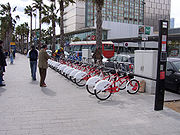
Montreal
Montreal is a city in Canada. It is the largest city in the province of Quebec, the second-largest city in Canada and the seventh largest in North America...
have implemented successful schemes known as community bicycle program
Community bicycle program
A bicycle sharing system is a service in which bicycles are made available for shared use to individuals who do not own them. Bicycle sharing systems can be divided into two general categories: "Community Bike programs" organized mostly by local community groups or non-profit organizations; and...
s or bike-sharing. These initiatives complement a city's public transport system and offer an alternative to motorized traffic to help reduce congestion and pollution. In Europe, especially in The Netherlands and parts of Germany and Denmark, commuting by bicycle is very common. In the Danish capital of Copenhagen
Copenhagen
Copenhagen is the capital and largest city of Denmark, with an urban population of 1,199,224 and a metropolitan population of 1,930,260 . With the completion of the transnational Øresund Bridge in 2000, Copenhagen has become the centre of the increasingly integrating Øresund Region...
, a cyclists' organization runs a Cycling Embassy, that promotes biking for commuting and sightseeing. The United Kingdom has a tax break scheme (IR 176) that allows employees to buy a new bicycle tax free to use for commuting.
In The Netherlands, all train stations are equipped with provisions for bicycle parking for free or a more secure parking place for a small fee and the larger ones also with bicycle repair shops, and cycling is so popular that the parking capacity is sometimes exceeded. In Delft the capacity is usually exceeded. In Trondheim
Trondheim
Trondheim , historically, Nidaros and Trondhjem, is a city and municipality in Sør-Trøndelag county, Norway. With a population of 173,486, it is the third most populous municipality and city in the country, although the fourth largest metropolitan area. It is the administrative centre of...
in Norway, the Trampe bicycle lift
Trampe bicycle lift
The Trampe bicycle lift is the first, and currently only, bicycle lift in the world. The prototype was built in 1993 in Trondheim, and it is still in service as of 2005. Trampe is a Norwegian verb meaning "to stomp".- Usage :...
has been developed to encourage cyclists by giving assistance on a steep hill. Action buses In Canberra, Australia, offers bicycle rack on the front of the bus to allow riders to mount their bicycle free of charge, and previously it would allow bicycle riders to ride on buses for free.
In cities where the bicycle is not an integral part of the planned transportation system, commuters often use bicycles as elements of a mixed-mode commute
Mixed-mode commuting
Mixed-mode commuting refers to the practice of using two or more modes of transportation. The goal of mixed-mode commuting is often to combine the strengths of various transportation options.-Mass transit:...
, where the bike is used to travel to and from train stations or other forms of rapid transit. Folding bicycles are useful in these scenarios, as they are less cumbersome when carried aboard. Los Angeles removed a small amount of seating on some trains to make more room for bicycles and wheel chairs.
Bicycles offer an important mode of transport in many developing countries. Until recently, bicycles have been a staple of everyday life throughout Asian countries. They are the most frequently used method of transport for commuting to work, school, shopping, and life in general.
Bicycles are also celebrated through use of visual art. An example of bicycles being appreciated through use of art, music, and film is the Bicycle Film Festival
Bicycle Film Festival
The Bicycle Film Festival is an independent film festival that takes place annually in 20-30 cities around the world, headquartered in New York City. It was established in 2001 by Brendt Barbur, after he was hit by a bus whilst riding his bike in New York City...
, a film festival hosted all around the world.
Poverty alleviation
Experiments done in Africa (UgandaUganda
Uganda , officially the Republic of Uganda, is a landlocked country in East Africa. Uganda is also known as the "Pearl of Africa". It is bordered on the east by Kenya, on the north by South Sudan, on the west by the Democratic Republic of the Congo, on the southwest by Rwanda, and on the south by...
and Tanzania
Tanzania
The United Republic of Tanzania is a country in East Africa bordered by Kenya and Uganda to the north, Rwanda, Burundi, and the Democratic Republic of the Congo to the west, and Zambia, Malawi, and Mozambique to the south. The country's eastern borders lie on the Indian Ocean.Tanzania is a state...
) and Sri Lanka
Sri Lanka
Sri Lanka, officially the Democratic Socialist Republic of Sri Lanka is a country off the southern coast of the Indian subcontinent. Known until 1972 as Ceylon , Sri Lanka is an island surrounded by the Indian Ocean, the Gulf of Mannar and the Palk Strait, and lies in the vicinity of India and the...
on hundreds of households have shown that a bicycle can increase the income of a poor family by as much as 35%. Transport, if analyzed for the cost-benefit analysis for rural poverty alleviation
Poverty reduction
Poverty is the state of human beings who are poor. That is, they have little or no material means of surviving—little or no food, shelter, clothes, healthcare, education, and other physical means of living and improving one's life....
, has given one of the best returns in this regard. For example, road investments in India were a staggering 3-10 times more effective than almost all other investments and subsidies in rural economy in the decade of 1990s. What a road does at a macro level to increase transport, the bicycle supports at the micro level. The bicycle, in that sense, can be one of the best means to eradicate poverty in poor nations.
Female emancipation
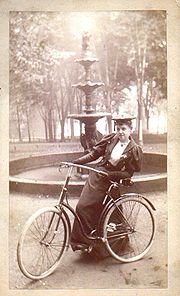
Safety bicycle
A safety bicycle is a type of bicycle that became very popular beginning in the late 1880s as an alternative to the penny-farthing or ordinary and is now the most common type of bicycle. Early bicycles of this style were known as safety bicycles because they were noted for, and marketed as, being...
gave women unprecedented mobility, contributing to their emancipation in Western nations. As bicycles became safer and cheaper, more women had access to the personal freedom they embodied, and so the bicycle came to symbolize the New Woman
New Woman
The New Woman was a feminist ideal that emerged in the late 19th century. The New Woman pushed the limits set by male-dominated society, especially as modeled in the plays of Norwegian Henrik Ibsen . "The New Woman sprang fully armed from Ibsen's brain," according to a joke by Max Beerbohm...
of the late 19th century, especially in Britain and the United States.
The bicycle was recognized by 19th-century feminists and suffragists as a "freedom machine" for women. American Susan B. Anthony
Susan B. Anthony
Susan Brownell Anthony was a prominent American civil rights leader who played a pivotal role in the 19th century women's rights movement to introduce women's suffrage into the United States. She was co-founder of the first Women's Temperance Movement with Elizabeth Cady Stanton as President...
said in a New York World
New York World
The New York World was a newspaper published in New York City from 1860 until 1931. The paper played a major role in the history of American newspapers...
interview on February 2, 1896: "Let me tell you what I think of bicycling. I think it has done more to emancipate women than anything else in the world. It gives women a feeling of freedom and self-reliance. I stand and rejoice every time I see a woman ride by on a wheel... the picture of free, untrammeled womanhood." In 1895 Frances Willard, the tightly laced president of the Women’s Christian Temperance Union, wrote a book called How I Learned to Ride the Bicycle, in which she praised the bicycle she learned to ride late in life, and which she named "Gladys", for its "gladdening effect" on her health and political optimism. Willard used a cycling metaphor to urge other suffragists to action, proclaiming, "I would not waste my life in friction when it could be turned into momentum."
The bicycle craze in the 1890s also led to a movement for so-called rational dress, which helped liberate women from corsets and ankle-length skirts and other restrictive garments, substituting the then-shocking bloomers
Bloomers (clothing)
Bloomers is a word which has been applied to several types of divided women's garments for the lower body at various times.-Fashion bloomers :...
.
Economic implications
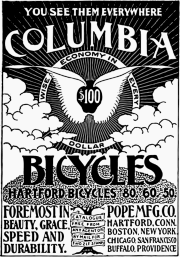
Bearing (mechanical)
A bearing is a device to allow constrained relative motion between two or more parts, typically rotation or linear movement. Bearings may be classified broadly according to the motions they allow and according to their principle of operation as well as by the directions of applied loads they can...
, washer
Washer (mechanical)
A washer is a thin plate with a hole that is normally used to distribute the load of a threaded fastener, such as a screw or nut. Other uses are as a spacer, spring , wear pad, preload indicating device, locking device, and to reduce vibration...
s, and sprocket
Sprocket
A sprocket or sprocket-wheel is a profiled wheel with teeth, cogs, or even sprockets that mesh with a chain, track or other perforated or indented material. The name 'sprocket' applies generally to any wheel upon which are radial projections that engage a chain passing over it...
s. These techniques later enabled skilled metalworkers and mechanics to develop the components used in early automobiles and aircraft.
They also served to teach the industrial models later adopted, including mechanization and mass production
Mass production
Mass production is the production of large amounts of standardized products, including and especially on assembly lines...
(later copied and adopted by Ford
Ford Motor Company
Ford Motor Company is an American multinational automaker based in Dearborn, Michigan, a suburb of Detroit. The automaker was founded by Henry Ford and incorporated on June 16, 1903. In addition to the Ford and Lincoln brands, Ford also owns a small stake in Mazda in Japan and Aston Martin in the UK...
and General Motors
General Motors
General Motors Company , commonly known as GM, formerly incorporated as General Motors Corporation, is an American multinational automotive corporation headquartered in Detroit, Michigan and the world's second-largest automaker in 2010...
), vertical integration (also later copied and adopted by Ford), aggressive advertising (as much as 10% of all advertising in U.S. periodicals in 1898 was by bicycle makers), lobbying for better roads (which had the side benefit of acting as advertising, and of improving sales by providing more places to ride), all first practised by Pope. In addition, bicycle makers adopted the annual model change (later derided as planned obsolescence
Planned obsolescence
Planned obsolescence or built-in obsolescence in industrial design is a policy of deliberately planning or designing a product with a limited useful life, so it will become obsolete or nonfunctional after a certain period of time...
, and usually credited to General Motors), which proved very successful.
Furthermore, early bicycles were an example of conspicuous consumption
Conspicuous consumption
Conspicuous consumption is spending on goods and services acquired mainly for the purpose of displaying income or wealth. In the mind of a conspicuous consumer, such display serves as a means of attaining or maintaining social status....
, being adopted by the fashionable elites. In addition, by serving as a platform for accessories, which could ultimately cost more than the bicycle itself, it paved the way for the likes of the Barbie doll.
Moreover, they helped create, or enhance, new kinds of businesses, such as bicycle messengers, travelling seamstresses, riding academies, and racing rinks (Their board tracks were later adapted to early motorcycle
Motorcycle racing
Motorcycle sport is a broad field that encompasses all sporting aspects of motorcycling. The disciplines are not all "races" or timed-speed events, as several disciplines test a competitor's various riding skills.-Motorcycle racing:...
and automobile racing.) Also, there were a variety of new inventions, such as spoke tighteners, and specialized lights, socks and shoes, and even cameras (such as the Eastman Company
Eastman Kodak
Eastman Kodak Company is a multinational imaging and photographic equipment, materials and services company headquarted in Rochester, New York, United States. It was founded by George Eastman in 1892....
's Poco). Probably the best known and most widely used of these inventions, adopted well beyond cycling, is Charles Bennett's Bike Web, which came to be called the "jock strap".
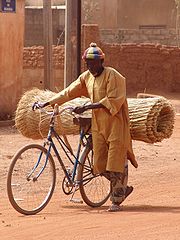
J. K. Starley's company became the Rover Cycle Company Ltd. in the late 1890s, and then simply the Rover Company when it started making cars. The Morris Motor Company
Morris Motor Company
The Morris Motor Company was a British car manufacturing company. After the incorporation of the company into larger corporations, the Morris name remained in use as a marque until 1984 when British Leyland's Austin Rover Group decided to concentrate on the more popular Austin marque...
(in Oxford
Oxford
The city of Oxford is the county town of Oxfordshire, England. The city, made prominent by its medieval university, has a population of just under 165,000, with 153,900 living within the district boundary. It lies about 50 miles north-west of London. The rivers Cherwell and Thames run through...
) and Škoda
Škoda Auto
Škoda Auto , more commonly known as Škoda, is an automobile manufacturer based in the Czech Republic. Škoda became a wholly owned subsidiary of the Volkswagen Group in 2000, positioned as the entry brand to the group...
also began in the bicycle business, as did the Wright brothers
Wright brothers
The Wright brothers, Orville and Wilbur , were two Americans credited with inventing and building the world's first successful airplane and making the first controlled, powered and sustained heavier-than-air human flight, on December 17, 1903...
. Alistair Craig, whose company eventually emerged to become the engine manufacturers Ailsa Craig
Ailsa Craig Engines
Ailsa Craig Engines was a manufacturer of marine and specialist made to order engines from 1891 to 1972. Named after the island Ailsa Craig, the company began as a bicycle manufacturer in Glasgow in 1891, later moving to Putney, in London where the then owner went into partnership and set about...
, also started from manufacturing bicycles, in Glasgow in March 1885.
In general, U.S. and European cycle manufacturers used to assemble cycles from their own frames and components made by other companies, although very large companies (such as Raleigh) used to make almost every part of a bicycle (including bottom brackets, axles, etc.) In recent years, those bicycle makers have greatly changed their methods of production. Now, almost none of them produce their own frames.
Many newer or smaller companies only design and market their products; the actual production is done by Asian companies. For example, some 60% of the world's bicycles are now being made in China. Despite this shift in production, as nations such as China
China
Chinese civilization may refer to:* China for more general discussion of the country.* Chinese culture* Greater China, the transnational community of ethnic Chinese.* History of China* Sinosphere, the area historically affected by Chinese culture...
and India
India
India , officially the Republic of India , is a country in South Asia. It is the seventh-largest country by geographical area, the second-most populous country with over 1.2 billion people, and the most populous democracy in the world...
become more wealthy, their own use of bicycles has declined due to the increasing affordability of cars and motorcycles.
One of the major reasons for the proliferation of Chinese-made bicycles in foreign markets is the lower cost of labor in China.
One of the profound economic implications of bicycle use is that it liberates the user from oil consumption (Ballantine, 1972). The bicycle is an inexpensive, fast, healthy and environmentally friendly mode of transport (Illich, 1974)
Manufacturing
The global bicycle market is $61 billion in 2011. 130 million bicycles are sold every year globally and 66% of them are made in China.Legal requirements
Early in its development, as with automobileAutomobile
An automobile, autocar, motor car or car is a wheeled motor vehicle used for transporting passengers, which also carries its own engine or motor...
s, there were restrictions on the operation of bicycles. Along with advertising, and to gain free publicity, Albert A. Pope litigated on behalf of cyclists.
The 1968 Vienna Convention on Road Traffic
Vienna Convention on Road Traffic
The Vienna Convention on Road Traffic is an international treaty designed to facilitate international road traffic and to increase road safety by standardising the uniform traffic rules among the contracting parties...
of the United Nations
United Nations
The United Nations is an international organization whose stated aims are facilitating cooperation in international law, international security, economic development, social progress, human rights, and achievement of world peace...
considers a bicycle to be a vehicle, and a person controlling a bicycle (whether actually riding or not) is considered an operator. The traffic codes of many countries reflect these definitions and demand that a bicycle satisfy certain legal requirements before it can be used on public roads. In many jurisdiction
Jurisdiction
Jurisdiction is the practical authority granted to a formally constituted legal body or to a political leader to deal with and make pronouncements on legal matters and, by implication, to administer justice within a defined area of responsibility...
s, it is an offense to use a bicycle that is not in a roadworthy condition.
In most jurisdictions, bicycles must have functioning front and rear lights when ridden after dark. As some generator or dynamo
Dynamo
- Engineering :* Dynamo, a magnetic device originally used as an electric generator* Dynamo theory, a theory relating to magnetic fields of celestial bodies* Solar dynamo, the physical process that generates the Sun's magnetic field- Software :...
-driven lamps only operate while moving, rear reflectors are frequently also mandatory. Since a moving bicycle makes little noise, some countries insist that bicycles have a warning bell for use when approaching pedestrians, equestrians, and other cyclists, though sometimes a car horn can be used when a 12 volt battery is available.
Some countries require child and/or adult cyclists to wear helmets
Bicycle helmet
A bicycle helmet is a helmet intended to be worn while riding a bicycle. They are designed to attenuate impacts to the skull of a cyclist in falls while minimizing side effects such as interference with peripheral vision...
, as this may protect riders from head trauma. Countries which require adult cyclists to wear helmets include Spain, New Zealand
Bicycle helmets in New Zealand
Bicycle helmets are mandatory in New Zealand, the only country with a helmet law enforced nationwide, requiring bicycle riders of all ages to wear helmets...
and Australia. Mandatory helmet wearing is one of the most controversial topics in the cycling world, with proponents arguing that it reduces head injuries and thus is an acceptable requirement, while opponents argue that by making cycling seem more dangerous and cumbersome, it reduces cyclist numbers on the streets, creating an overall negative health effect (fewer people cycling for their own health, and the remaining cyclists being more exposed through a reversed safety in numbers
Safety in numbers
Safety in numbers is the hypothesis that, by being part of a large physical group or mass, an individual is proportionally less likely to be the victim of a mishap, accident, attack, or other bad event...
effect).
See also
- CyclingCyclingCycling, also called bicycling or biking, is the use of bicycles for transport, recreation, or for sport. Persons engaged in cycling are cyclists or bicyclists...
– use of bicycles - Outline of bicyclesOutline of bicyclesThe following outline is provided as an overview of and topical guide to bicycles:Bicycle – pedal-driven, human-powered, single-track vehicle, having two wheels attached to a frame, one behind the other. A person who rides a bicycle is called a cyclist or a bicyclist, and the activity is...
General
Special uses and related vehicle types
Other
- Human-powered transportHuman-powered transportHuman-powered transport is the transport of person and/or goods using human muscle power. Like animal-powered transport, human-powered transport has existed since time immemorial in the form of walking, running and swimming...
- Safety standardsSafety standardsSafety standards are standards designed to ensure the safety of products, activities or processes, etc. They may be advisory or compulsory and are normally laid down by an advisory or regulatory body that may be either voluntary or statutory...
- Transportation technology, timeline ofTimeline of transportation technology-Antiquity:*Stone Age – Dugout canoes*3500 BC – Wheeled carts are invented in Mesopotamia*3500 BC – River boats are invented *3100 BC – Horses are tamed and used for transport Botai Egypt *2000 BC – Chariots built by Indo-Iranians...
External links
- Pedaling History Museum The world's largest bicycle museum
- A range of Traffic Advisory Leaflets produced by the UK Department for TransportDepartment for TransportIn the United Kingdom, the Department for Transport is the government department responsible for the English transport network and a limited number of transport matters in Scotland, Wales and Northern Ireland which are not devolved...
covering cycling. - A History of Bicycles and Other Cycles at the Canada Science and Technology MuseumCanada Science and Technology MuseumThe Canada Science and Technology Museum is located in Ottawa, Ontario, on St. Laurent Boulevard, to the south of the Queensway .-Mission:...

